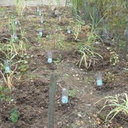Tobacco, Sunflower and High Biomass SRC Clones Show Potential for Trace Metal Phytoextraction on a Moderately Contaminated Field Site in Belgium.
Lykilorð
Útdráttur
Phytoextraction could be a potential management option for diffusely Cd-Zn-Pb-polluted agricultural land in Northeast Belgium. The use of high yielding crops with a sufficiently high metal accumulation is preferred as these are expected to both gradually decontaminate the soil while generating an income through biomass valorization. To find out which high biomass crop possessed the highest and most constant (in time) phytoextraction potential on these soils, different plant species and different mutants or clones of each species, were evaluated during consecutive years. Biomass production and metal accumulation of pre-selected tobacco somaclonal variants (Nicotiana tabacum L.) and pre-selected sunflower mutants (Helianthus annuus L.) were investigated for two productivity years, while the phytoextraction potential of experimental poplar (Populus) and willow (Salix) in short rotation coppice (SRC) was assessed at the end of the second cutting cycle (after two times four growing seasons). The tobacco clones and the sunflower mutants showed efficient extraction of, respectively, Cd and Zn, while the highest simultaneous extractions of Cd and Zn were gained with some SRC clones. Variation in biomass production and metal accumulation were high for all crops over the years. The highest biomass production was observed for the experimental poplar clone of the crossing type Populus deltoides (P. maximowiczii x P. trichocarpa) with 9.9 ton DW per ha per year. The remediation period to reach legal threshold values for the pseudo-total content of Cd in this specific soil was estimated to be at least 60 years. Combining estimated phytoextraction potential and economic and environmental aspects, the SRC option is proposed as the most suitable crop for implementing metal phytoextraction in the investigated area.


